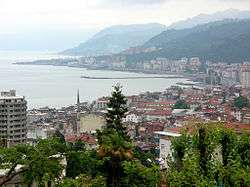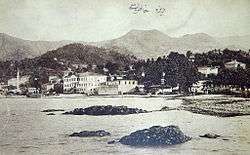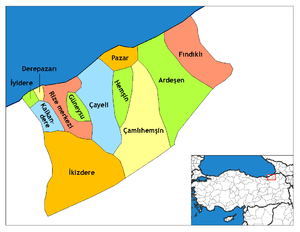Rize
| Rize | |
|---|---|
| Municipality | |
 View of Rize | |
 Rize | |
| Coordinates: 41°01′29″N 40°31′20″E / 41.02472°N 40.52222°ECoordinates: 41°01′29″N 40°31′20″E / 41.02472°N 40.52222°E | |
| Country | Turkey |
| Province | Rize |
| Government | |
| • Mayor | Reşat Kasap (AKP) |
| Area[1] | |
| • District | 250.14 km2 (96.58 sq mi) |
| Population (2012)[2] | |
| • Urban | 104,508 |
| • District | 141,524 |
| • District density | 570/km2 (1,500/sq mi) |
| Post code | 53000 |
| Climate | Cfa |
| Website | www.rize.bel.tr |
Rize is the capital city of Rize Province in the eastern part of the Black Sea Region of Turkey.
Name
The name comes from Greek ρίζα (riza) or Ριζαίον (Rizaion), meaning "mountain slopes",ρίζα in Greek means root.[3] In modern times, its name in Greek was usually Ριζούντα (Rizunda). Its Latin forms are Rhizus and Rhizaeum, the latter of which is used in the Catholic Church's list of titular sees as the name of bishopric of the town, which was once part of the late Roman province of Pontus Polemoniacus[4]). The name Rize is spelled ريزه in Ottoman Turkish, and რიზე in Georgian. The name in Laz is Rizini (რიზინი).[5]
History
The first written mention of Rize is made by Arrian in a work named Periplus of the Euxine Sea,[6] as a city founded at the mouth of the homonymous river (the ancient and Byzantine ῾Ρίζιος ποταμός[7]). Dated at 130–131 AD and written as a letter to Roman Emperor Hadrian, the work records how its author, the governor of Cappadocia, made an inspection tour of the Eastern Black Sea territories that were part of his jurisdiction, first visiting the Roman Empire's Eastern Anatolian frontier garrisons before pushing on to the Black Sea coast in the Trabzon (Trebizond) region.[8]
The city of Rize formed part of historic Georgian province of Chaneti (Georgian: ჭანეთი). From 1547 Chaneti province was incorporated by the Ottoman Empire and became a part of the sancak of Lazistan. The city was claimed by the short-lived Democratic Republic of Georgia between 1918 and 1920. On the basis of the 1921 Treaty of Kars, Soviet Russia granted Rize to Turkey just as the other territories of Artvin, Ardahan, and Hopa (Georgian: ხუფათი).
Geography

The city is built around a small bay on the Black Sea coast, on a narrow strip of flat land between the sea and the mountains behind. The coastal strip is being expanded with landfill and the city is growing up the steep hillsides away from the coast. Rize enjoys a mild, extremely wet climate, vulnerable to storms coming off the Black Sea and therefore the surrounding countryside is rich with vegetation and is attracting more and more visitors every year.
Rize is a center for processing and shipping Rize Tea, the tea grown in the surrounding area. Tea was introduced in the region in the 1940s and 1950s, changing the destiny of the region, which was desperately poor until then.[9] The city has a tea research institute founded in 1958 and tea gardens are the main sight in the town's panoramic view. Tea and kiwifruit plants are even planted in gardens around the town. The secondary activity is fishing. Rize is linked by road with Trabzon (41 miles [66 km] west), Hopa (55 miles [88 km] east on the Georgian border, and Erzurum (north). The nearest airport is in Trabzon.
Rize is a quiet town, a typical Turkish provincial capital with little in the way of night life or entertainment. However the border with Georgia has been open since the early 90's, the Black Sea coast road has been widened and Rize is now wealthier than in previous decades; there are more cars in the streets, higher buildings on the sea front, and some places for young people to go are opening up now. The visitors to the surrounding countryside also contribute to the economy of the town.
Climate
Rize has a humid subtropical climate (Köppen climate classification: Cfa). Snowfall can be heavy once it snows. The climate turns continental (Dfb) on the hillsides and subarctic (Dfc) on mountain slopes and yaylas, a term used in Turkish for highlands and highland plateaus.
Rize and the eastern part of the Black Sea coast where it is situated has the highest precipitation in western Asia, with an annual precipitation averaging around 2,500 millimetres (100 in), with heavy rainfall year-round and a maximum in late autumn (October to December). The Black Sea coast receives the greatest amount of precipitation in Turkey and is the only region of Turkey that receives high precipitation throughout the year. The water temperature, as in the whole Turkish Black Sea coast, is always cool, fluctuating between 8 and 20 °C (46 and 68 °F) throughout the year.
| Climate data for Rize (1928–2017) | |||||||||||||
|---|---|---|---|---|---|---|---|---|---|---|---|---|---|
| Month | Jan | Feb | Mar | Apr | May | Jun | Jul | Aug | Sep | Oct | Nov | Dec | Year |
| Record high °C (°F) | 24.3 (75.7) |
28.1 (82.6) |
32.6 (90.7) |
35.8 (96.4) |
38.2 (100.8) |
36.1 (97) |
35.4 (95.7) |
35.6 (96.1) |
34.6 (94.3) |
33.8 (92.8) |
30.4 (86.7) |
26.7 (80.1) |
38.2 (100.8) |
| Average high °C (°F) | 10.5 (50.9) |
10.6 (51.1) |
11.8 (53.2) |
15.3 (59.5) |
19.3 (66.7) |
23.4 (74.1) |
25.8 (78.4) |
26.4 (79.5) |
23.8 (74.8) |
20.3 (68.5) |
16.4 (61.5) |
12.7 (54.9) |
18.0 (64.4) |
| Daily mean °C (°F) | 6.7 (44.1) |
6.6 (43.9) |
8.0 (46.4) |
11.6 (52.9) |
16.0 (60.8) |
20.2 (68.4) |
22.7 (72.9) |
23.0 (73.4) |
20.0 (68) |
16.1 (61) |
12.0 (53.6) |
8.7 (47.7) |
14.3 (57.7) |
| Average low °C (°F) | 3.7 (38.7) |
3.5 (38.3) |
4.8 (40.6) |
8.3 (46.9) |
12.5 (54.5) |
16.5 (61.7) |
19.5 (67.1) |
19.9 (67.8) |
16.8 (62.2) |
13.0 (55.4) |
9.0 (48.2) |
5.6 (42.1) |
11.1 (52) |
| Record low °C (°F) | −6.5 (20.3) |
−6.6 (20.1) |
−7 (19) |
−2.8 (27) |
1.0 (33.8) |
7.8 (46) |
10.0 (50) |
9.8 (49.6) |
4.6 (40.3) |
2.5 (36.5) |
−4.8 (23.4) |
−4 (25) |
−7.0 (19.4) |
| Average precipitation mm (inches) | 233.3 (9.185) |
186.6 (7.346) |
161.0 (6.339) |
96.5 (3.799) |
95.7 (3.768) |
133.8 (5.268) |
152.4 (6) |
195.4 (7.693) |
253.9 (9.996) |
295.3 (11.626) |
257.3 (10.13) |
237.6 (9.354) |
2,298.8 (90.504) |
| Average precipitation days | 14.6 | 14.3 | 15.6 | 14.8 | 14.2 | 13.8 | 13.7 | 14.2 | 14.5 | 14.8 | 13.5 | 14.2 | 172.2 |
| Mean monthly sunshine hours | 68.2 | 87.6 | 111.6 | 135.0 | 173.6 | 198.0 | 167.4 | 161.2 | 150.0 | 130.2 | 90.0 | 65.1 | 1,537.9 |
| Mean daily sunshine hours | 2.2 | 3.1 | 3.6 | 4.5 | 5.6 | 6.6 | 5.4 | 5.2 | 5.0 | 4.2 | 3.0 | 2.1 | 4.2 |
| Source: Turkish State Meteorological Service[10] | |||||||||||||
Economy
Historically, Rize grew oranges. However, weather destroyed the crops in the early 20th century, and the industry declined.[11] The area also produced small amounts of manganese.[12]
The economic structure of Rize is based primarily around its geographic location. Rize is a very mountainous city, making industrial development difficult and impractical. Given the lack of air and rail transit, most goods have to travel by truck or ship, which makes exporting and importing difficult. Rize's primary trading partner is Trabzon, the most developed city of northeast Black Sea region. Rize's main exports are agriculturally based; tea and kiwifruit are among its most popular commodities.
Education
Rize University was founded in 2006, and its name was changed to Recep Tayyip Erdoğan University by the university senate's approval.
Culture
- Rize Castle, a partly-ruined medieval castle southwest of the city center.
Sports
Sports venues in Rize are Rize Atatürk Stadium, Yeni Rize Şehir Stadı and Rize Sports Complex consisting of Rize Sports Hall and Rize Indoor Swimming Pool.
The football team of Çaykur Rizespor play in the Süper Lig. Pazarspor football team compete in the TFF Third League.
History
Notable natives
- Kazım Ayvaz – Olympic medalist and world champion in wrestling
- Zafer Biryol – football player
- Nikos Kapetanidis – journalist and newspaper publisher
- İbrahim Çolak- member of Istanbul provincial council
- Recep Tayyip Erdoğan – politician, former prime minister and current president of Turkey
- Temel Kotil – aeronautical engineer and CEO of Turkish Airlines
- Tuncay Mataracı (born 1935) – convicted former government minister
- Mehmet Akif Pirim – Olympic medalist in Greco-Roman wrestling
- Köksal Toptan – politician
- İsmail Türüt – singer of folk music of the Black Sea region
- Yaşar Yılmaz – wrestler
- Mesut Yılmaz – politician and former prime minister
Çaykur Rizespor, the local football team, play in the Turkish Super League and are local heroes, occasionally capable of defeating even the big Istanbul teams. They play in green and blue, reflecting the blue of the sea and the green of the tea growing on the hillsides.
Others who have never lived in Rize but come from Rize families include:
- Sezen Aksu – singer and songwriter, born in Izmir but originally from Pazar/Rize
- Tarkan – pop singer
Population
| Year | Population |
|---|---|
| 1975 | 36,044 |
| 1980 | 43,407 |
| 1985 | 50,221 |
| 1990 | 52,031 |
| 1997 | 73,420 |
| 2000 | 78,144 |
| 2009 | 96,503 |
Notes
- ↑ "Area of regions (including lakes), km²". Regional Statistics Database. Turkish Statistical Institute. 2002. Retrieved 2013-03-05.
- ↑ "Population of province/district centers and towns/villages by districts - 2012". Address Based Population Registration System (ABPRS) Database. Turkish Statistical Institute. Retrieved 2013-02-27.
- ↑ Rize Archived 2008-05-13 at the Wayback Machine. article from Özhan Öztürk, Encyclopedia of Black Sea (Karadeniz Ansiklopedik Sözlük), 2005
- ↑ Annuario Pontificio 2013 (Libreria Editrice Vaticana, 2013, ISBN 978-88-209-9070-1), p. 959
- ↑ Öztürk claims that it amy be related with Laz irizeni means "flat places" Özhan Öztürk.Pontus: Antiçağ’dan Günümüze Karadeniz’in Etnik ve Siyasi Tarihi. Ankara, 2011 ISBN 978-605-54-1017-9 pp. 739–740
- ↑ An Overview of Rize's History
- ↑ Περίπλους τοῦ Εὐξείνου Πόντου
- ↑ The Periplus of the Euxine Sea. Oxford: sold by J. Cooke; and by Messrs. Cadell and Davies Strand, London. 1805. Note: Arrian only mentions the River Rhizius, not any settlement by that name. It is quoted as being to the east of the river Ophis after the rivers Psychrus and Calus.
- ↑ Rize Çayı ve Rize kenti (tr)
- ↑ "Resmi İstatistikler: İllerimize Ait Genel İstatistik Verileri" (in Turkish). Turkish State Meteorological Service. Archived from the original on 22 April 2018. Retrieved 22 April 2018.
- ↑ Prothero, W.G. (1920). Armenia and Kurdistan. London: H.M. Stationery Office. p. 62.
- ↑ Prothero, W.G. (1920). Armenia and Kurdistan. London: H.M. Stationery Office. p. 73.
References
- [Encyclopedic Dictionary of Black Sea]. 2 Cilt. Heyamola Yayıncılık. Istanbul. ISBN 978-975-6121-00-9
External links
| Wikimedia Commons has media related to Rize. |
